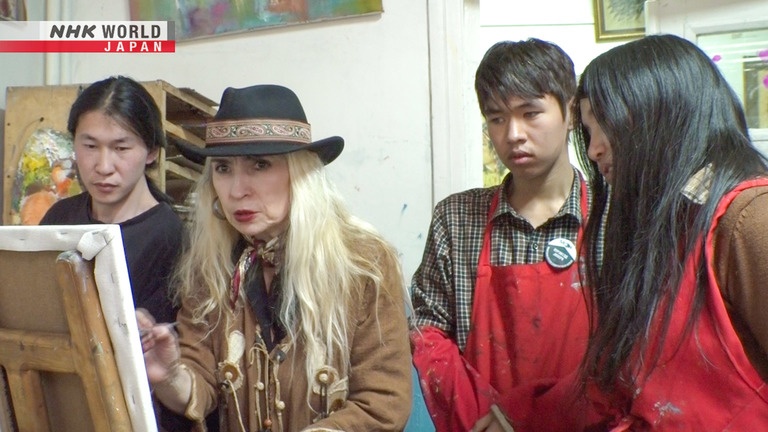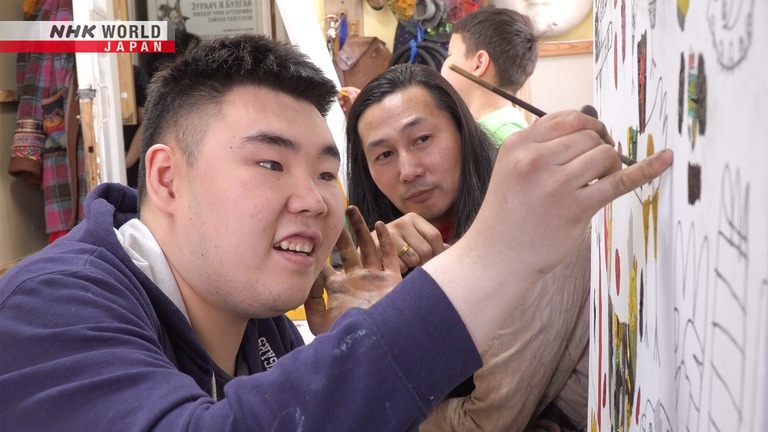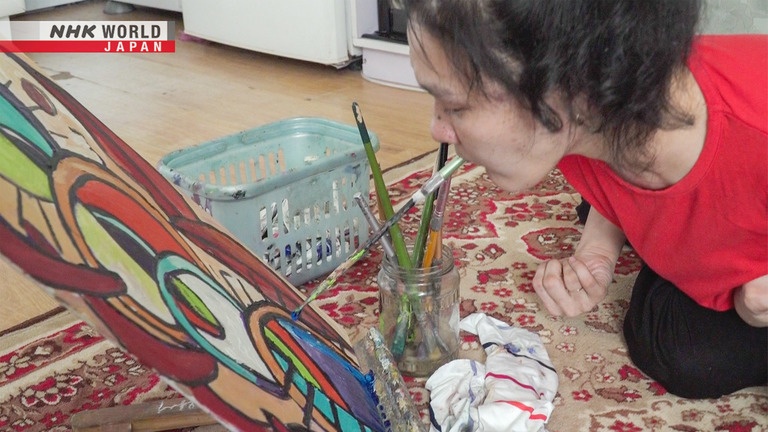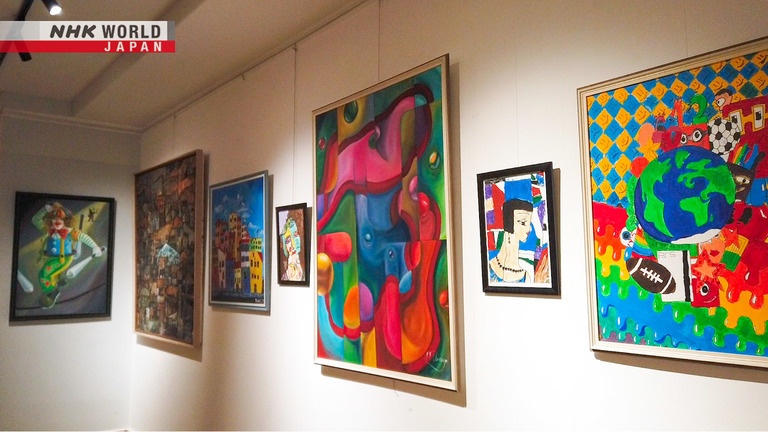To Live is to Paint: Mongolia
Mongolia's capital Ulaanbaatar is home to the country's only art school that accepts students with disabilities. Currently, 13 of its 50 students have intellectual or physical disabilities. One graduate is now a professional artist who has enjoyed success in the US and Japan. Accessibility remains a challenge in Mongolia, and there are few educational and employment opportunities for people with disabilities. Many live isolated from society. By teaching students of all abilities side by side, the school has become a source of hope for many students and their families. As the school approaches its 30th anniversary, meet the students chasing their artistic dreams, and the principal and teachers who guide them.




Transcript
"Kitchen" by Temuulen? That's over here.
April 2023.
A gallery in Ulaanbaatar is preparing for an art show.
108 paintings will be exhibited, all created by people with disabilities.
This is the work of a woman with cerebral palsy.
A girl in a wheelchair can be seen behind a mass of legs -
- a reflection of the harsh realities of living with a disability.
This work is by a man with hearing loss.
It depicts the joy of music that he experiences through vibrations with his feet.
This three-part work was painted by a man with autism.
A cast of characters riding horses create a story like the illustrations of a picture book.
The exhibition is being held by Mongolia's only art school that accepts students with disabilities.
My nephew really changed
after he started at this school.
He's become more independent.
The teachers and students here
have helped him adapt to society.
Around 110,000 people in Mongolia live with a disability.
They have difficulties accessing education and employment, and many are left behind by society.
Accessibility in Mongolia also remains a challenge.
Don't rush your first sketches.
Over its 30 years of history, the art school's principal has worked to provide equal access to students of all abilities.
Painting is simply one way
to live life to the fullest.
What matters is finding yourself
and your own way to live.
This is the story of one Mongolian art school
that is using the creativity of art to bring hope to students with disabilities and their families.
Mongolia's capital, Ulaanbaatar.
A recent wave of modernization has seen new skyscrapers cover the city.
This Russian Orthodox church stands in the city's west.
It's home to a private art school.
The ANIMA Art Design School.
'Anima' is a Latin word meaning soul, or spirit.
The school has seven teachers and fifty students, aged between 16 and 37.
Students spend four years learning painting from the basics all the way to advanced techniques.
Currently, 13 of the students have disabilities.
Iosif has total hearing loss.
This one is called "Unwavering Path".
The red line is my life.
The other colors depict various things
that have happened over that time.
The school has no nursing or mental health specialists, and no sign language interpreters.
Fellow students help out when necessary.
Let me go, let me go!
This boy is part of the children's painting group held twice a week.
He is autistic and struggles with communication.
Let's play an instrument. Yeah?
Look here.
Play an instrument?
The teacher suggests activities the boy enjoys
and waits patiently until he calms down.
School principal, Bulgan Yadamsuren.
Look closely. This hue is too strong.
- And this part?
- Shadow.
Her grandmother was Russian, and her grandfather and both her parents were artists.
Bulgan herself is well known in Mongolia.
She opened the school in 1994, and has sent over 300 students to graduation.
Humans do not make art.
Art makes humanity.
Some will become artists.
But that's not our only goal.
Art helps people become part
of society and find themselves.
This is called "Traffic".
A 2012 graduate with cerebral palsy spent six months working on this piece.
Today we face constant
waves of technology.
Urbanization has made it hard
to make a living.
I don't know where this road
is going or where it will end.
But the artist had hope that
something was going to change.
A tree has been cut down
but the child cradles a sapling.
It's a new start.
Some students are pursuing a career in art.
Third-year student Undarmaa has a physical disability.
She can hold things between her fingers, but can't move them freely.
I pour all my pain into my paintings.
That's why the tones are dark and gloomy.
They express things
I can't talk to people about.
I'm scared of what people
will think of me if I do.
My art reflects the color of my mind.
A self-portrait with her eyes closed.
Undarmaa is still troubled by bitter memories from her childhood.
Classmates said I had camel hands.
That it was divine punishment for stealing.
I was always hurting, crying.
I didn't want to go to school.
She graduated high school and found work through an acquaintance.
But it was mostly mundane jobs and she sometimes wasn't paid.
Undarmaa learned of the art school through social media.
She'd always loved painting and decided to sign up and start over.
Now 37, she'll graduate next year.
She's both excited and anxious about how far she can progress in the time that's left.
The school has struggled with a perennial problem since it opened: a lack of funding.
Classrooms and corridors are left in need of repair.
Sometimes they cannot afford to buy paint.
Tuition at the school is 470 US dollars a year.
But many students come from poor families and pay a discounted rate.
Some have their tuition waived entirely.
Teachers receive the minimum Mongolian wage of 150 dollars a month.
All of them have side jobs in Ulaanbaatar teaching painting.
But principal Bulgan has never considered closing the school's doors.
She has faith that her beloved grandfather would do the same, were he still alive.
Her grandfather Yadamsuren Urjin is the artist
who revived traditional Mongolian painting from the verge of extinction under socialism.
He was honored as the People's Artist of Mongolia in 1965.
But he never traded on his fame.
A quiet man, he always treated everyone equally and fairly.
When I was a child, all kinds
of people visited our home.
Poor people, homeless people, alcoholics.
My grandfather welcomed them all with respect.
My grandmother would cook
for these guests.
I watched him talk to them all.
It moved me deeply.
Before Bulgan opened the school, Mongolia was in a period of social turmoil following its democratization.
Workers lost their jobs, and families began to fall apart.
Many children chose to live in the sewers to escape parental violence and shelter from the cold.
This is one of Bulgan's works from that period.
Pearl necklaces represent the pure heart that every child has, no matter how poor or dirty.
A few years later, Bulgan used what she inherited from her grandfather to help children through art.
Eventually word spread that her new school would accept anyone who loved art, and people with disabilities began to apply.
The Anima art school has given one family new hope for the future.
Enkhsaikhan graduated in 2018.
She has cerebral palsy and can't stand on her own.
With limited control of her hands, she holds her paintbrush in her mouth.
Working seven hours a day on a large canvas, it takes her nearly two months to complete a painting.
Her mother, Baiggalmaa, raised her alone, earning a living as a railway worker.
No elementary school would accept Enkhsaikhan,
until a special state-run school offered her a place when she was 11.
She attended for ten years, but found it hard to communicate with her classmates.
She made no friends, and her mother worried constantly.
But after joining Anima at age 21, Enkhsaikhan's student life took on a very different hue.
Her mother was concerned about the long commute, when principal Bulgan made an exciting suggestion.
She said they'd vacate a room
in the school for us to live in.
Everyone here welcomed us.
They helped us so much.
For the first time, Enkhsaikhan studied alongside classmates without disabilities,
and took part in all kinds of school events.
My life just kept on changing.
Painting helped me become an adult.
Today, Enkhsaikhan is a professional artist,
taking inspiration from things she loves, like musical instruments and flowers.
She has sold over 50 paintings in Mongolia, the US, and Japan.
It was hard at first, but then
she sold a painting in the US.
It felt like it was all worth it.
It always makes me cry.
Hopes are already high for the career of one current student.
21-year-old Khuvit is autistic.
Most students graduate after four years, but Khuvit is in his eighth.
Finding employment is a challenge, and both he and his family want him to stay at the school.
He understands and can use simple words, but communication isn't easy.
Khuvit is taught by Barkhuu, a former graduate of Anima who is also married to principal Bulgan.
Show me. Show me.
- Good.
- Good?
- Thank you!
- Thank you!
Whenever he has a concern, Khuvit comes to Barkhuu.
He asks him to stop the cameras because he can't concentrate on his painting.
He's never violent.
He's a real gentleman.
He came here eight years ago, aged 14.
Bulgan and I taught him how to paint.
Now his work astonishes me.
All done. Finished.
Have some chocolate.
He's happy now.
An Ulaanbaatar hotel is home to a gallery that supports young artists.
Khuvit's work has been on display here since last year.
The gallery has already sold three of his pieces for 400 dollars each.
The owner says he fell for Khuvit's paintings at first sight.
I think the wonderful thing about his paintings is the sense of color and the sense of composition.
So here she is taking her glove off so she can use her hand to touch the horse.
And I think the details like that are very sensitive.
The Anima school has made it through difficult times.
But it's now facing a major crisis: the church from which the school operates has asked it to move out.
They need the space for dormitories for priests.
For the last 12 years, the church has supported the school's work, providing space for almost no rent at all.
Bulgan is grateful and wants to comply with the request.
But she cannot afford to move.
If the school does close down, some students will have nowhere to go.
The school is a small island providing a
habitat for the children and teachers.
We're a community.
That's why the students enjoy it here.
We need a better environment
for the children.
I want to raise wages too.
Bulgan consults with the teachers and they decide to hold an art exhibition to mark the school's 30th anniversary.
Students and graduates will sell their paintings, and part of the profit will be used to fund a move.
The students get straight to work on paintings for the exhibition.
Undarmaa is also working on an exhibition piece.
This is the motif.
I'm drawn to the fantastical recently.
Her new painting is titled "Butterfly Dream."
A butterfly cradles a baby.
Undarmaa says it's a reflection of herself.
This is my dream.
To be a strong woman
expressed in these colors.
At 4PM, Undarmaa heads home.
It's a two-hour journey by bus.
She quit her job to study art,
so her income is limited to around 70 dollars a month from the national disability pension.
It's hard to make ends meet, but she's determined to keep going until she succeeds as an artist.
She's motivated by her 13-year-old daughter, Sarnai.
Undarmaa is a single mother - Sarnai has never met her father.
All mom's work is beautiful.
I see how she feels when she paints
so I understand them best.
What do you love best about her?
Everything.
Any examples?
She lets me do what I want.
She praises and kisses me.
She cooks for me, we go out
together and she buys me things.
My daughter is the source
of hope in my life.
I have to work hard for her future.
I will paint for her until I die.
April 29, 2023.
The opening of the exhibition.
The students are all dressed up for the occasion.
Undarmaa has brought her daughter.
This is one of Ulaanbaatar's top galleries.
The exhibition was funded by donations from families and supporters of the school.
108 works by students and graduates are on display, and they draw 250 visitors on the first day alone.
The students are delighted to see their work displayed in such a large venue.
It's the first time Sarnai has seen her mother's latest painting.
I'm so happy everyone
gets to see mom's work.
It's healing to see the finished work.
It soaked up all of my pain.
The painting titled "Traffic" displayed at the school is the work of graduate Zolboo.
I love painting.
To live is to paint.
The exhibition lasts seven days and sells twelve paintings.
70% of the profit goes to the artists, and 30% to the school.
It's not enough to fund a move, but it's a major step forward for the students.
Painting lets you find and heal yourself
regardless of ability.
It's a path to tackling
your hidden problems.
The exhibition ends and the school returns to its usual routine.
Undarmaa's exhibition painting sold for 240 dollars.
It's a small, but very concrete source of confidence.
An art school that helps students of all abilities realize their dreams.
Bulgan is determined to protect a space for her pupils.